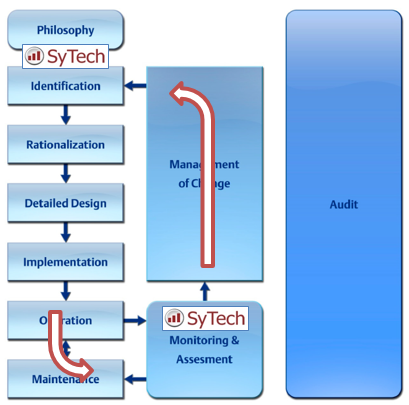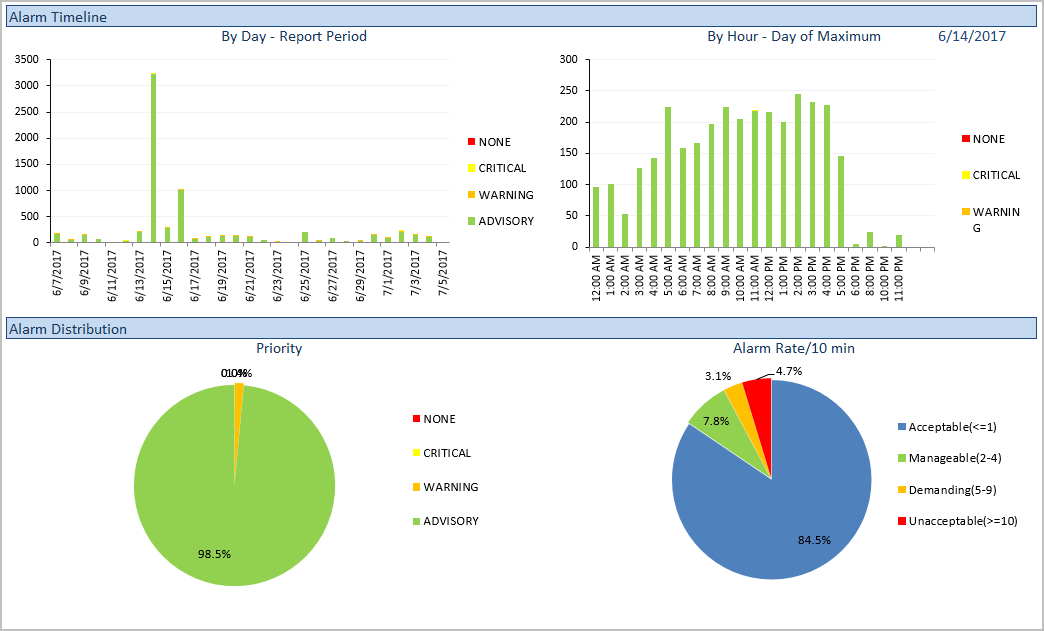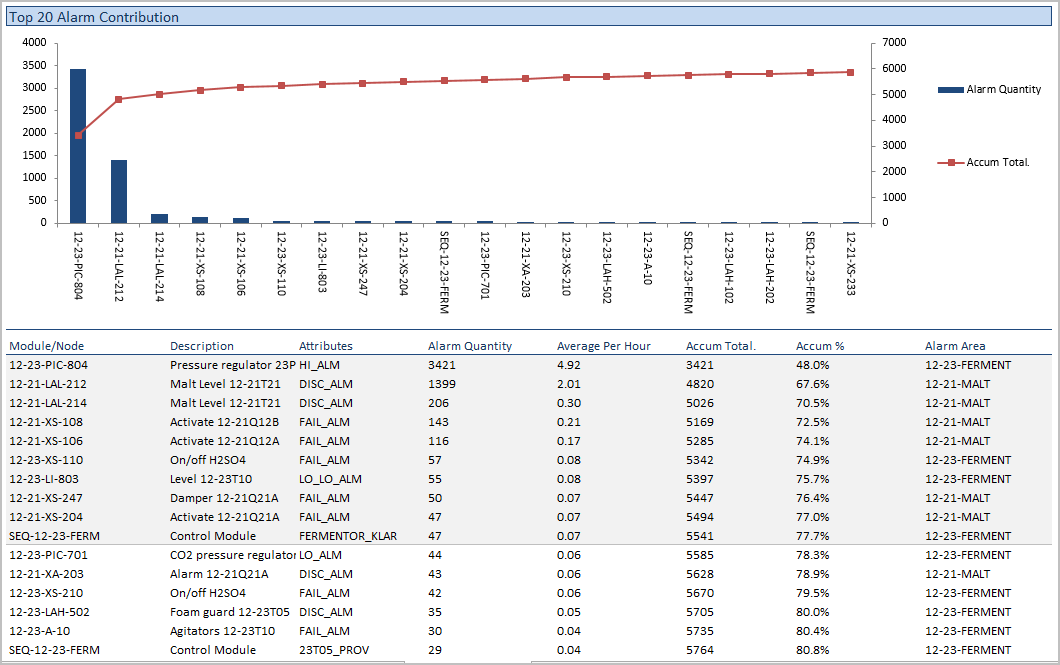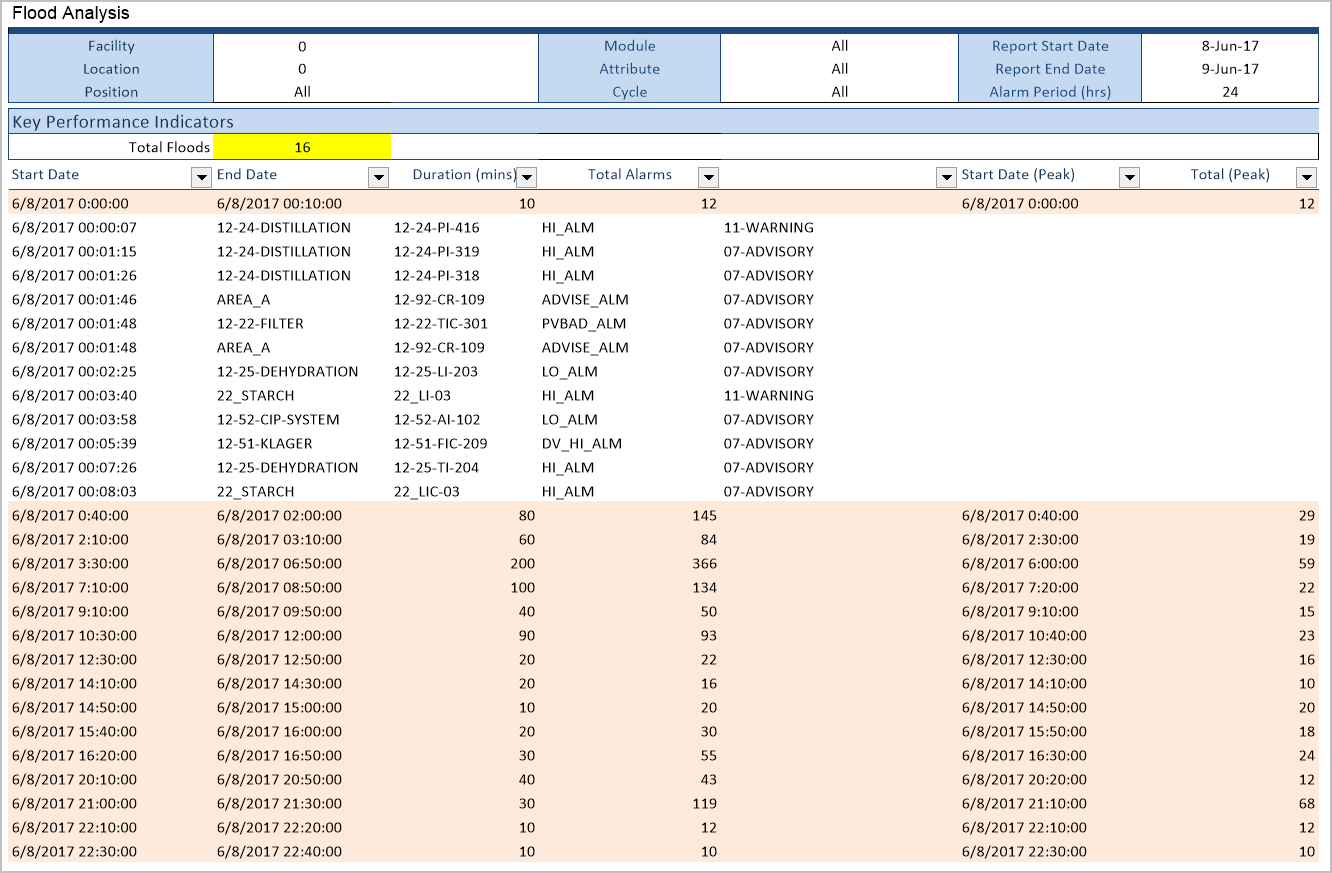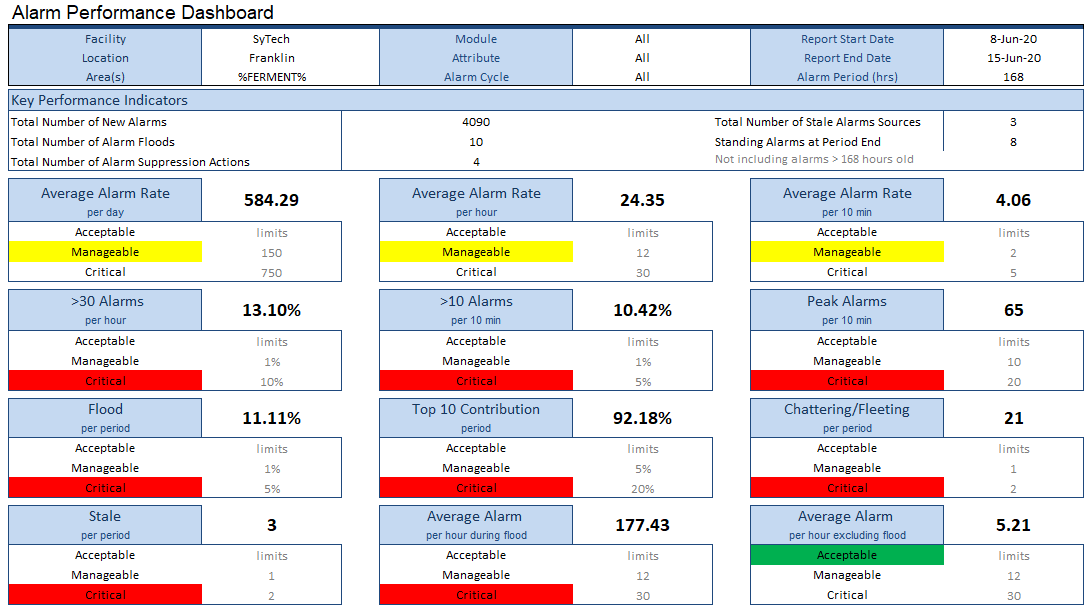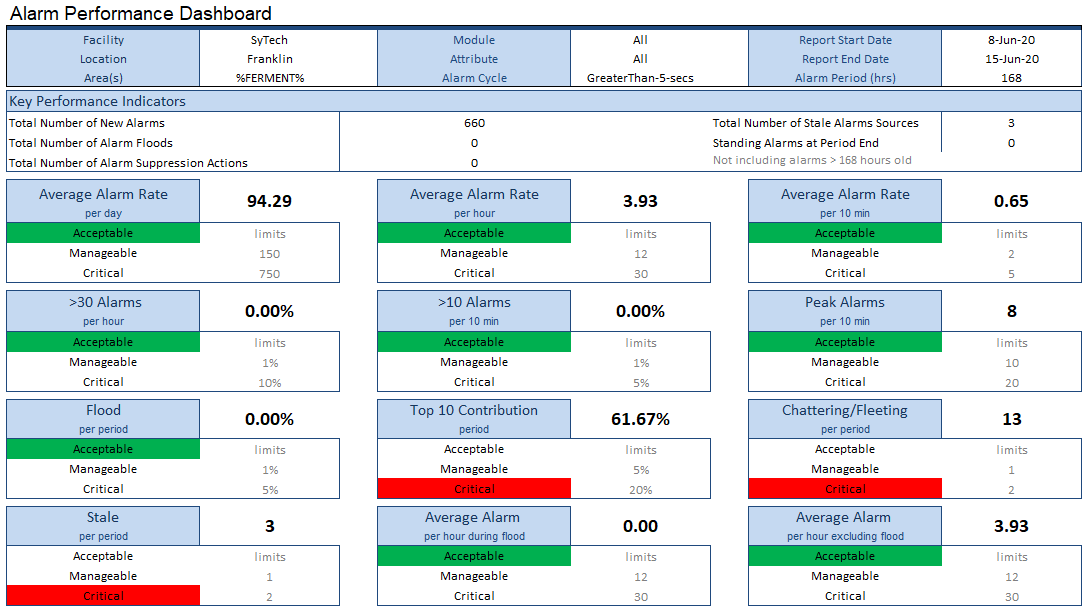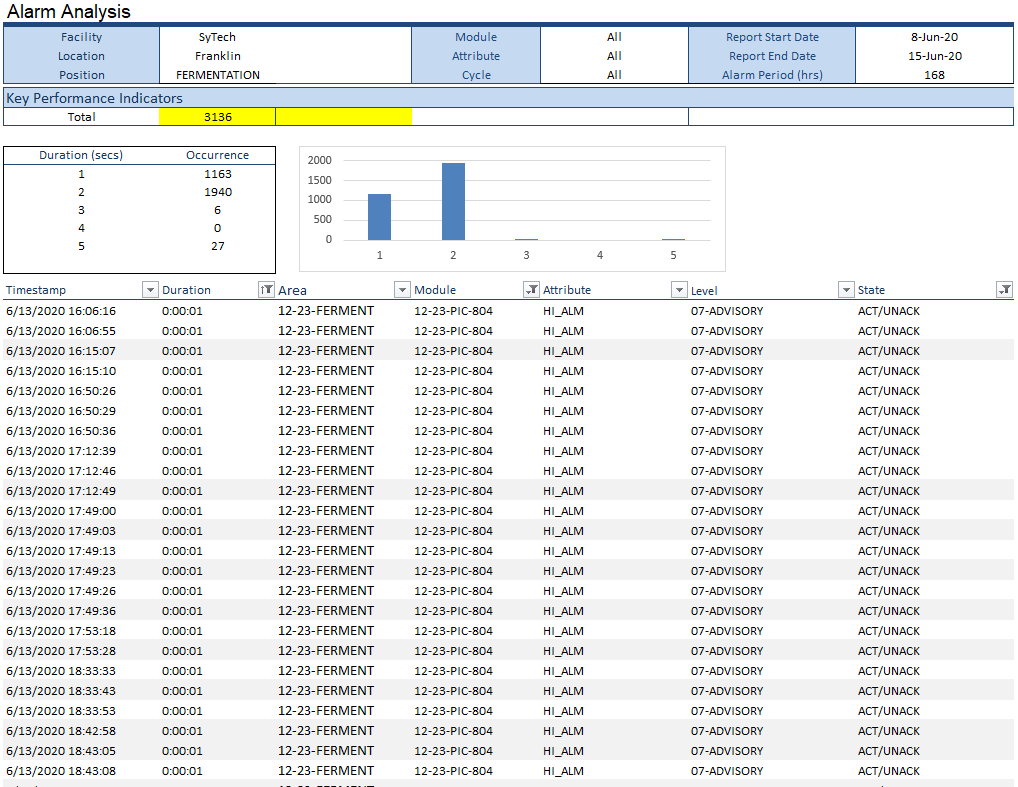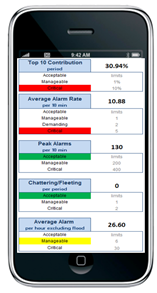ISA-18.2 and IEC 62682
Alarm ManagementIncrease production and operator effectiveness
See also:
 Video on ISA-18.2 and IEC-62682 Alarm Management
Video on ISA-18.2 and IEC-62682 Alarm Management
 Slides on ISA-18.2 and IEC-62682 Alarm Management
Slides on ISA-18.2 and IEC-62682 Alarm Management
Research has shown that a well managed alarm system results in production efficiency, product quality and operator effectiveness.
Since 1991, alarm management standards have been published and currently the ISA-18.2 and IEC 62682 are the most widely accepted. The standards define a 7-step Alarm Management Cycle program from Identification to Monitoring and Assessment.
XLReporter provides two levels of alarm analysis reports.
Since 1991, alarm management standards have been published and currently the ISA-18.2 and IEC 62682 are the most widely accepted. The standards define a 7-step Alarm Management Cycle program from Identification to Monitoring and Assessment.
XLReporter provides two levels of alarm analysis reports.
- Standard Reports from database queries
- Advanced ISA 18.2, IEC 62682 Compliant Reports as part of the Monitoring and Assessment step
Automated KPI Dashboard
XLReporter periodically calculates the performance of an alarm system and distributes the results automatically by email or web browser. A dashboard showing the Key Performance Indicators (KPIs)
uses configurable targets to show the health of the alarm system in an "at-a-glance" display. For KPIs out of specification, the necessary information is provided to serve as a guide for improvement (Rationalization).
For large alarm systems SyTech has partnered with exida who can provide recommendations on how to address the gaps, as well as creating an alarm management program.
For large alarm systems SyTech has partnered with exida who can provide recommendations on how to address the gaps, as well as creating an alarm management program.
Alarm Priority Distribution
Alarm prioritization provides a mechanism for placing a qualititive value of importance of an alarm.
The priority usually signifies how quickly the operator should respond to an alarm. Guidelines for a three-priority system distribution are reflected in the standards:
- ~80% Low Priority
- ~15% Medium Priority
- ~5% High Priority
Nuisance Alarms
Nuisance alarms can cause operator distraction and, more importantly, obscure the visibility of alarms that should be concerning. They are usually a handful of alarms, which if addressed,
will create noticeable positive change for the operator and improve the KPIs of the system.
To identify nuisance alarm, the Standards suggest measuring the "Bad Actors" by the percentage of alarms coming from the top-ten most frequent alarm sources relative to the total count which is shown on a histogram/pareto chart.
Contributors:
To identify nuisance alarm, the Standards suggest measuring the "Bad Actors" by the percentage of alarms coming from the top-ten most frequent alarm sources relative to the total count which is shown on a histogram/pareto chart.
Contributors:
- Chattering and fleeting alarms
- Misuse of the alarm system
Alarm Floods
Identifying alarm floods quantify how much of the opertor's time is spent within highly stressful circumstance of receiving more alarms than can be managed effectively.
The Standards define the start of an alarm flood as a 10 minute period when there are more than 10 alarms and ends when there are less than 5 alarms in 10 minutes.
To identify alarm floods a drill-down flood report is used. At top-level the floods are displayed and each flood is expanded to show the alarms that participated.
Contributors:
The Standards define the start of an alarm flood as a 10 minute period when there are more than 10 alarms and ends when there are less than 5 alarms in 10 minutes.
To identify alarm floods a drill-down flood report is used. At top-level the floods are displayed and each flood is expanded to show the alarms that participated.
Contributors:
- Cascading alarms
- Poor control design
Powerful Filters
Any improvement to your alarm system starts by identifying problem areas. XLReporter provides four levels of filtering which help reveal the "needles in the haystack".
- Operator Position
Use this filter to see the alarm activity being experienced by each operator. - Module
Use this filter to see the alarm activity for certain tags in the system. - Attribute
Use this filter to see the alarm activity for certain tag attibutes in the system e.g., HI-HI. - Cycle
Use this filter to see the alarm activity excluding alarms for a specified cycle time i.e., the time taken from active to inactive states.
Applying a cycle filter representing cycle times less than or equal to 5 seconds reduces the alarm activity shown in the previous dashboard from 4090 new alarms to 660 new alarms.
In other words, identifying the alarms with a cycle time less than or equal to 5 seconds results in an over 80% reduction in alarm activity.
In other words, identifying the alarms with a cycle time less than or equal to 5 seconds results in an over 80% reduction in alarm activity.
How can alarms with a short activity be identified?
XLReporter provides an Analysis template to simply the task.
The template identifies that of the 3136 new alarms with a cycle time of less than or equal to 5 seconds, the module 12-23-PIC-804 occured 3136 times.
Taking this analysis further, a bar chart of the duration to activity reveals that most of the time, the new alarm activity was less than 3 seconds.
Possible actions with this knowledge is to investigate the module alarm setpoints or adjust its on-delay.
XLReporter provides an Analysis template to simply the task.
The template identifies that of the 3136 new alarms with a cycle time of less than or equal to 5 seconds, the module 12-23-PIC-804 occured 3136 times.
Taking this analysis further, a bar chart of the duration to activity reveals that most of the time, the new alarm activity was less than 3 seconds.
Possible actions with this knowledge is to investigate the module alarm setpoints or adjust its on-delay.
KPIs Explained
-
Average Alarm Rate per day, per hour, per 10 minsA useful initial measure of the overall performance of the alarm system. Trending the daily alarm rate can reveal periods of low and high alarm activity. If activity is high then the the next two metrics should be considered.
-
Percentage of time with more than 30 alarms/hourPercentage of time with more than 30 alarms per hour.
-
Percentage of time with more than 10 alarms/10 minsPercentage of time with more than 10 alarms per 10 minutes.
-
Peak alarm count in 10 minsMaximum number of new alarms occuring in 10 minutes. This metric should be considered with alarm floods.
-
Percentage of time in alarm floodAn alarm flood starts when there more than 10 new alarms in 10 minutes and ends when there are less than 5 alarms in 10 minutes. This metric indicates the percentage of time the system was in a flood state. This could be an indicator of chattering alarms, cascading alarms, system alarms or non-alarm notifications.
-
Percent contribution of the 10 most active alarmsIdentifying the most active alarms can lead to substantial performnce improvements.
-
Number of chattering/fleeting alarmsThe number of alarms that have a short activation time. These are nuisance alarms that can be rectified, once identified.
-
Number of Stale AlarmsThe number of alarms that have been active for more than 24 hours. Following their initial appearance they provide no information and clutter alarm displays.
-
Average Alarm Rate per hour during floodAverage alarm rate per hour during flood periods.
-
Average Alarm Rate per hour excluding floodAverage alarm rate per hour outside of flood periods.
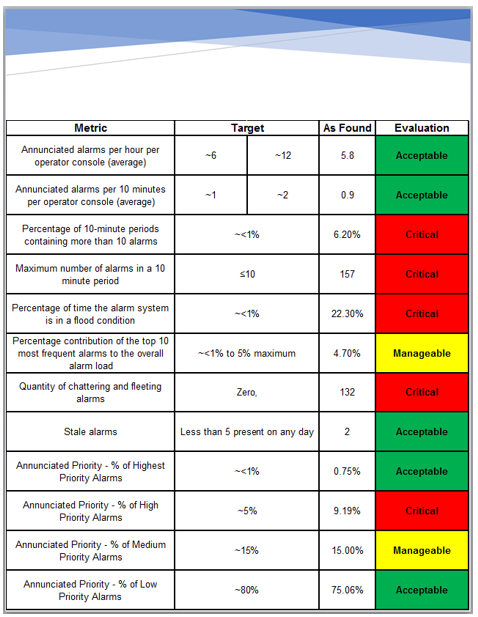
Try XLReporter
Download the evaluation version of XLReporter and generate Montoring and Assessment reports today.
The reports are limited in content (because of the evaluation license) but give you a clear picture of what is possible.
Alarm Databases Supported:
Alarm Databases Supported:
- Rockwell Software FactoryTalk Alarms and Events
- Emerson Automation Solutions DeltaV Event Chronicle
- Emerson Automation Solutions DeltaV Batch Alarms
- AVEVA Historian Alarms
- Siemens SIMATIC PCS7
